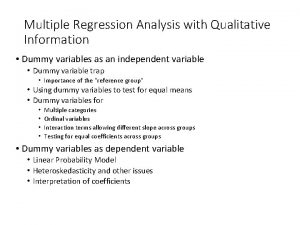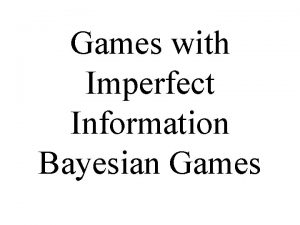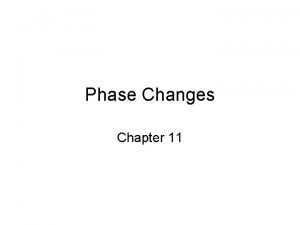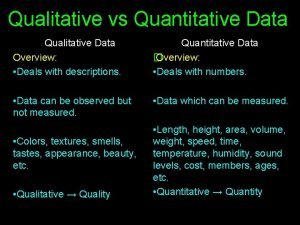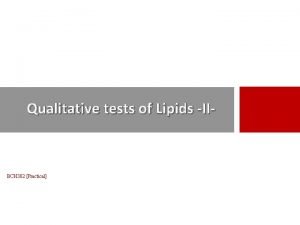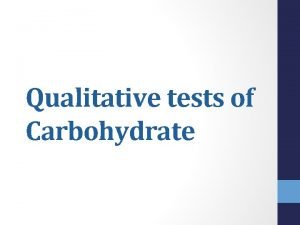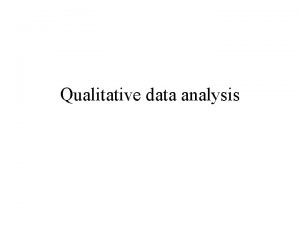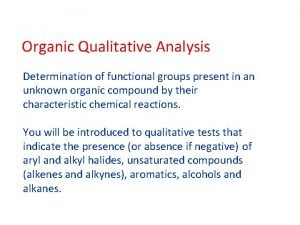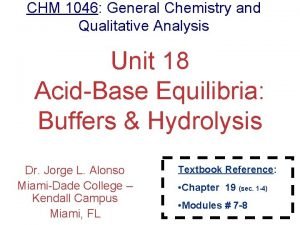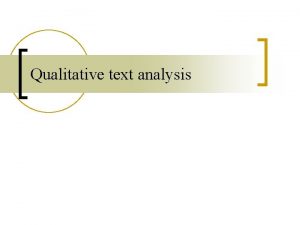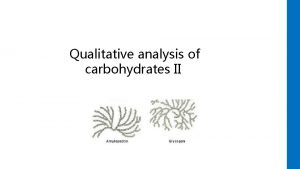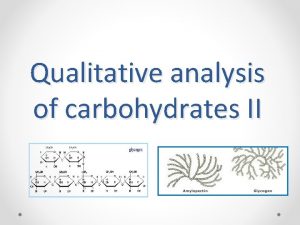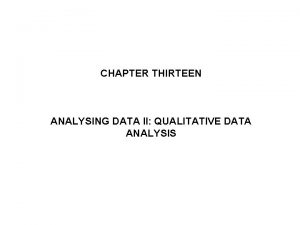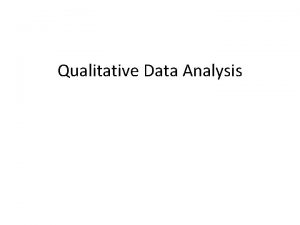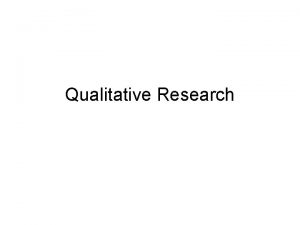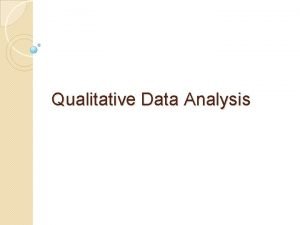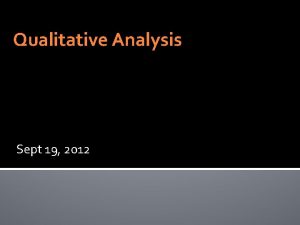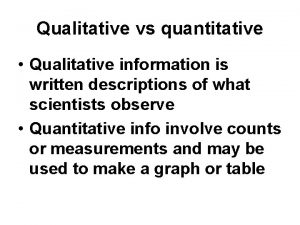qualitative phase analysis qualitative phase analysis Which information





































- Slides: 37

qualitative phase analysis

qualitative phase analysis Which information can be extracted from a measurement? (relevant parameters)

qualitative phase analysis - How to find out the phase composition of the sample? - What is a ‚phase‘? : - area of constant crystal structure & chemical composition - separated by phase boundaries XRD carries almost no information on materials chemistry!

qualitative phase analysis basic principle - crystal structure -> Bragg angle positions - atoms in the crystal structure (kind, position) -> relative intensities - every material has a fingerprint: position+intensity - goal: - create databases for the collection of fingerprints - assure that an unknown substance is found with a high probability in a pool of database entries - identification of a phase from a limited group of possible compounds identify the fingerprint of a phase in the diffraction pattern of a samle!

qualitative phase analysis diffraction patterns with different complexity Cu

qualitative phase analysis diffraction patterns with different complexity Zr

qualitative phase analysis diffraction patterns with different complexity Ga

qualitative phase analysis diffraction patterns with different complexity Pb. WO 4

qualitative phase analysis methods - diffraction pattern is a 2 q-dependent series of peak maxima - contains information on : - interplanar distances - symmetry (= systematic extinctions) - crystal structure - atomic positions - types of atoms find agreement between measured diffraction pattern and one or more patterns in the database advantage of XRD: when elements, say A and B, are in the sample, then XRD is able to identify in which phase (crystal structure) the compound is present

qualitative phase analysis methods - input information - expectation of phases - chemical composition of the sample - assumptions regarding symmetry - non-ambien conditions - problems: database entries are typically different from the measured data - change in lattice parameters (concentation differences, solid solutions, etc. ) - change of intensities due to texture, bad grain statistics, solid solutions, etc. ) - change in diffraction angle due to instrumental abberations

qualitative phase analysis methods - searching in databases by hand is impossible (>100000 database entries) - electronic databases: electronic search Boolean search - old manual search routines are now used by computers! - alphabetic index - Hanawalt index (1936) - Fink index (1968) - … -> How do they work?

qualitative phase analysis methods Hanawalt-Index (1936) - comparison of peak positions (= dhkl-values) and relative peak intensities - sorting of diffraction patterns with decreasing dhkl for the strongest line - creates an efficient manual search algorithm - works also with unknown substances - since multiple substances may have their strongest line in a similar dhkl-range, 2 nd and 3 rd strongest lines are also used - database entries are grouped according to d 1 - and d 2 -values

qualitative phase analysis methods Hanawalt-Index (1936) - convert 2 q in dhkl - determine relative intensities (rough estimate) - find strongest line in group 1 (d 1) search in this group the best agreement with d 2 continue with d 3 whenn 3 lines were identified, compare all lines whenn agreement is found: phase identified!

qualitative phase analysis Hanawalt index: search for the strongest lines with large interplanar distance 14

qualitative phase analysis 15

qualitative phase analysis measured data, interplanar distances from the Hanawalt index unknown: 2. 48 X 2. 816 1. 634 2. 603 1. 483 1. 383 1. 912 2. 092 2. 552 1. 602 3. 481 1. 741 2. 381 1. 411 1. 401 1. 361 Zn. O: 2. 48 X 2. 816 2. 604 1. 623 1. 483 1. 912 1. 382 1. 361 a-Al 2 O 3: 2. 09 X 2. 559 1. 608 3. 488 1. 375 1. 745 2. 384 1. 403 16

qualitative phase analysis methods Fink-Index (1968) - based on the 8 strongest lines of a diffraction pattern - higher wight is given to the dhkl compared to Hanawalt index - 8 strongest lines are sortet according to their dhkl e. g. d 13 d 21 d 32 d 4 d 54 d 6 d 7 d 8 exponent: intensity - comparison of the 8 peak positions with those in the database, where the strongest lines are at d 2, d 3, d 1, d 5 liegt z. B. d 1 d 21 d 3 d 4 d 5 d 6 d 7 d 8 d 1 d 2 d 31 d 4 d 5 d 6 d 7 d 8 permutation of line positions d 11 d 2 d 3 d 4 d 5 d 6 d 7 d 8 d 1 d 2 d 3 d 4 d 51 d 6 d 7 d 8 - repeated for the 4 strongest lines - the higher FN, the better the agreement

qualitative phase analysis methods Fink-Index (1968) - grouping based on 8 strongest lines in diffraction pattern - 4 entries for every diffraction pattern, each of which starts with a different of the 4 strongest lines - thereafter, sorted with decreasing dhkl - Fink index more appropriate than Hanawalt index, when: - many equally strong lines - many lines with large dhkl (large unit cells) - preferred orientation or bad grain statistics -> weights the line positions more than Hanawalt index

qualitative phase analysis Fink index: search for lines with the largest dhkl 19

qualitative phase analysis databases - all databases result from the work of Hanawalt - = systematic assortment of characteristic diffraction patterns of different substances - old databases used (paper) cards - accompanied by books with alphabetic and numeric index - alphabetic index: entries sorted by name (when the composition of the sample is known) - numerical index: d 1, d 2, d 3 and intensities (unknown sample)

qualitative phase analysis databases (as of 2007) >400000 (2020)

qualitative phase analysis PDF-ICDD database pattern database - contains experimental and calculated diffraction patterns - most complete and most frequently used database - contains: - card number and quality mark - some general information (chemistry, structure, …) - experimental conditions upon creation of the pattern - data source - crystal system and space group - unit cell, formula units and melting point - density, figure of merit, unit cell volume - citation - colour - comments (sample synthesis, non-standard conditions) - digitised version of the diffraction pattern (dhkl, relative intensities, Laue indices)

qualitative phase analysis PDF-ICDD database

qualitative phase analysis PDF-ICDD database - PDF quality marks: pattern database * highest quality of a measured diffraction pattern, chemical composition well known, no systematic errors, D 2 q < 0. 03° I ‚indexed‘ (single physe with high probability), sufficiently large 2 q-range, no severe systematic errors, D 2 q < 0. 06 0 data of insufficiently known material, data of low precision B ‚blank‘, data do not suffice conditions for *, I, 0 D ‚deleted‘, dataset deleted due to wrong data or replacement by better data, remains for retracing R ‚Rietveld‘, dhkl directly from Rietveld refinement, unusual C ‚calculated‘, diffraction patter calculated from single crystal data, precise dhkl, intensities may differ from real values, contains reference to the crystal structure database A alternative for different C datasets

qualitative phase analysis ICSD database contains: - collection code and date - name of the compound - structure formula and sum formula - theoretical density - citation - lattice parameter and unit cell volume - number of formula units - space group (different symbols) - boundary conditions (e. g. non ambient) - links to ICDD-PDF database (if applicable) - structure type - atom positions (x, y, z) - occupancy - Debye-Waller factors (if applicable) crystal structure database

qualitative phase analysis ICSD database

qualitative phase analysis automatic search: Search-Match routines - use digitsed databases - use of restrictions by logical operators: chemical elements, compound names, expected crystal structure, etc. - search usually uses Hanawalt (or Fink) scheme - critical parameters: - number of reflections (position, intensity) - number of strong(est) lines - tolerance (allowed difference between measured data and database entry) - automated search algorithms create many more solutions than appropriate: continue with manual search

qualitative phase analysis automatic search: Search-Match routines Assessment of the search results: - for only few strong lines, all should be found in the data strong difference in intensity: texture, bad grain statistics, … or other reasons? check experimental conditions (wavelength, diffractometer, …) -> intensity qualitative agreement of relative intensities expected solved structure: hypothetical, metastable? fit of ambient/non-ambient conditions

qualitative phase analysis examples bad match! - Beugungsbild der unbekannten Phase reduced data no match

qualitative phase analysis examples good match! - Beugungsbild der unbekannten Phase arows missing in theoretical pattern nearly perfect, but H missing isostructural compounds arrows: missing in the data

qualitative phase analysis examples - Beugungsbild der unbekannten Phase good match! multiple phases

qualitative phase analysis systematic extinction of diffraction maxima - orthorhombic crystal (space group Pnma) - primitive cell = no systematic extinctions due to centering of the unit cell

Crystallographic point groups (crystal classes) point group crystal system view direction 1, 1 triclinic (anorthic) 2, m, 2/m monoclinic [010] 222, 2 mm, mmm (2/m 2/m) orthorhombic [100], [010], [001] 4, 4, 4/m tetragonal 422, 4 mm, 42 m, 4/mmm (4/m 2/m) [001], [100], [110] 3, 3 32, 3 m (3 2/m) [001], [100], [120] (hex) [111], [1 -10] (rhomb. ) trigonal 6, 6, 6/m hexagonal 622, 6 mm, 62 m, 6/mmm (6/m 2/m) [001], [100], [120] 23, m 3 (2/m 3) 432, 43 m, m 3 m (4/m 3 2/m [100], [111], [110] cubic 33 Beispiele http: //ruby. chemie. uni-freiburg. de/Vorlesung/symmetrie_2_5_1. html

qualitative phase analysis systematic extinction of diffraction maxima - orthorhombic crystal (space group Pnma) - primitive cell = no systematic extinctions due to centering of the unit cell n-glide plane perpendicular to a extinction for k+l = 2 n+1, all other reflections present

qualitative phase analysis systematic extinction of diffraction maxima - orthorhombic crystal (space group Pnma) - primitive cell = no systematic extinctions due to centering of the unit cell m-mirror plane perpendicular to b no systematic extinctions due to mirror planes

qualitative phase analysis systematic extinction of diffraction maxima - orthorhombic crystal (space group Pnma) - primitive cell = no systematic extinctions due to centering of the unit cell a-glide plane perpendicular to c only reflections with h = 2 n are present

qualitative phase analysis systematic extinction of diffraction maxima - orthorhombic crystal (space group Pnma) - primitive cell = no systematic extinctions due to centering of the unit cell consistency check all systematic absences have to found in all (projected) diffraction patterns - reflections along (0 k 0) only for k = 2 n, along (00 l) only for l = 2 n
 Multiple regression analysis with qualitative information
Multiple regression analysis with qualitative information Normal phase vs reverse phase chromatography
Normal phase vs reverse phase chromatography M tswett pronunciation
M tswett pronunciation Mobile phase and stationary phase
Mobile phase and stationary phase Mobile phase in chromatography
Mobile phase in chromatography Normal phase vs reverse phase chromatography
Normal phase vs reverse phase chromatography Line vs phase voltage
Line vs phase voltage Adsorption chromatography
Adsorption chromatography Phase to phase voltage
Phase to phase voltage Csce 441
Csce 441 Convenience sampling images
Convenience sampling images Quantitative vs qualitative observations
Quantitative vs qualitative observations Imperfect vs incomplete information game
Imperfect vs incomplete information game Which moon phase occurs directly before a new moon
Which moon phase occurs directly before a new moon Predictive analytics life cycle
Predictive analytics life cycle Which moon phase occurs directly before a new moon
Which moon phase occurs directly before a new moon Forward reference table (frt) is arranged like ?
Forward reference table (frt) is arranged like ? Which phase transforms srs document into a form easily
Which phase transforms srs document into a form easily What causes the phases of the moon
What causes the phases of the moon Is vaporization endothermic or exothermic
Is vaporization endothermic or exothermic Qualitative researcch has holistic nature
Qualitative researcch has holistic nature Ualitative data
Ualitative data Qualitative vs quantitative
Qualitative vs quantitative Power bi qualitative data
Power bi qualitative data Qualitative test for lipids experiment
Qualitative test for lipids experiment Carbohydrates introduction
Carbohydrates introduction Principles of qualitative data analysis
Principles of qualitative data analysis Qualitative analysis of organic functional groups
Qualitative analysis of organic functional groups General chemistry with qualitative analysis
General chemistry with qualitative analysis Qualitative vs quantitative data analysis
Qualitative vs quantitative data analysis What are qualitative skills
What are qualitative skills Semi quantitative analysis definition
Semi quantitative analysis definition Qualitative text analysis
Qualitative text analysis Political science methodology
Political science methodology Iodine test
Iodine test Iodine test principle
Iodine test principle Data analysis in research example qualitative
Data analysis in research example qualitative Miles and huberman 1994
Miles and huberman 1994
